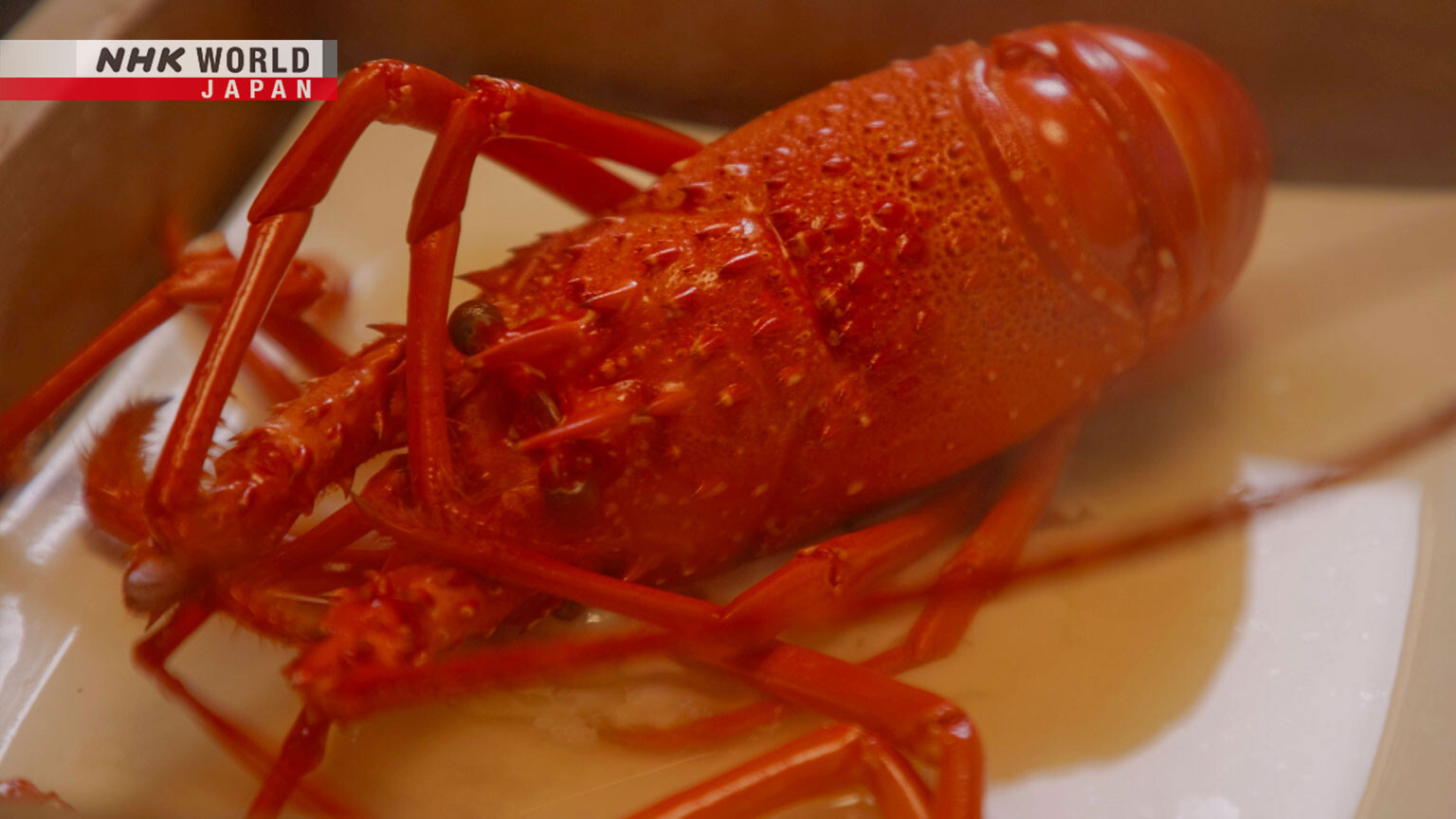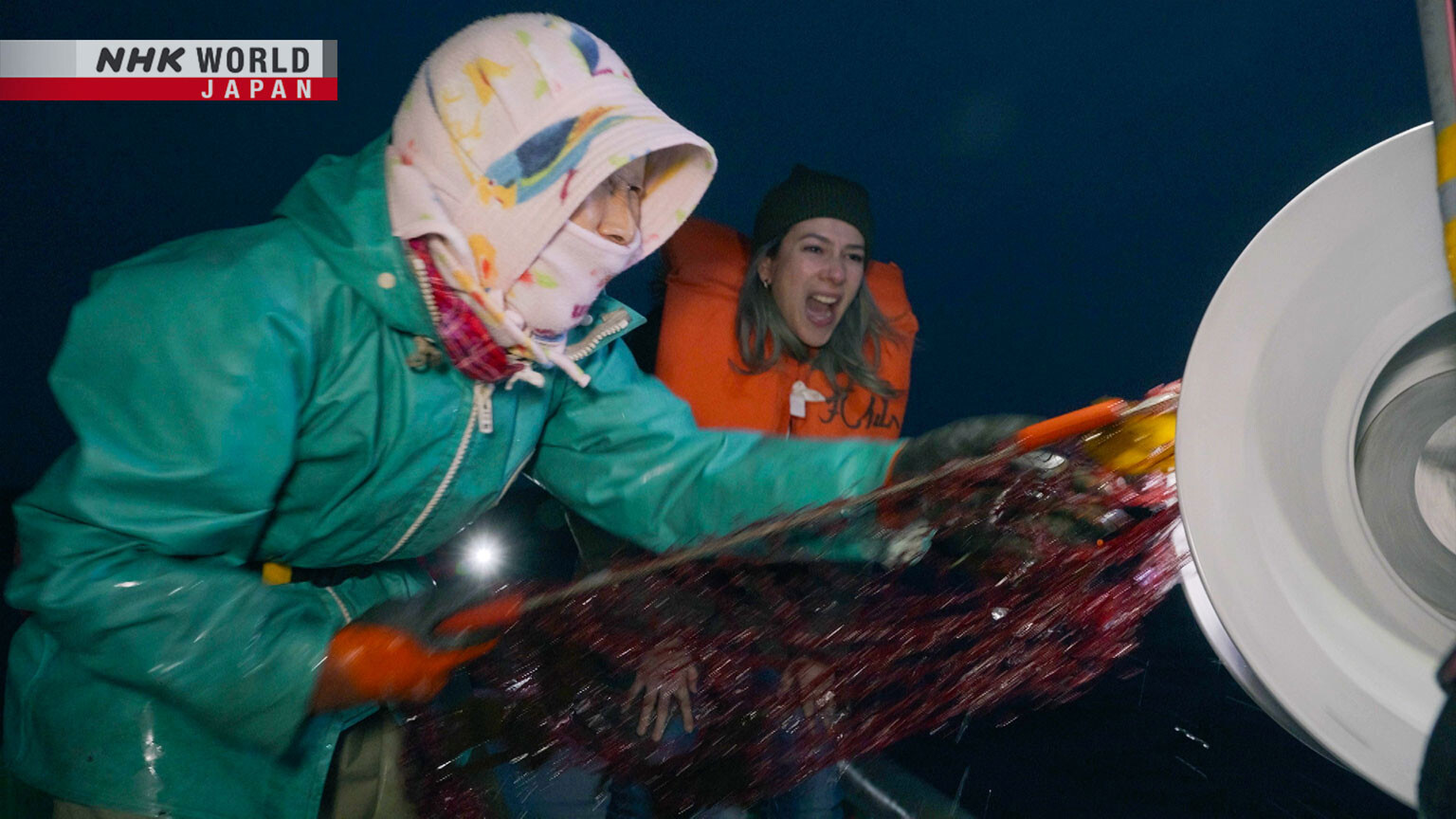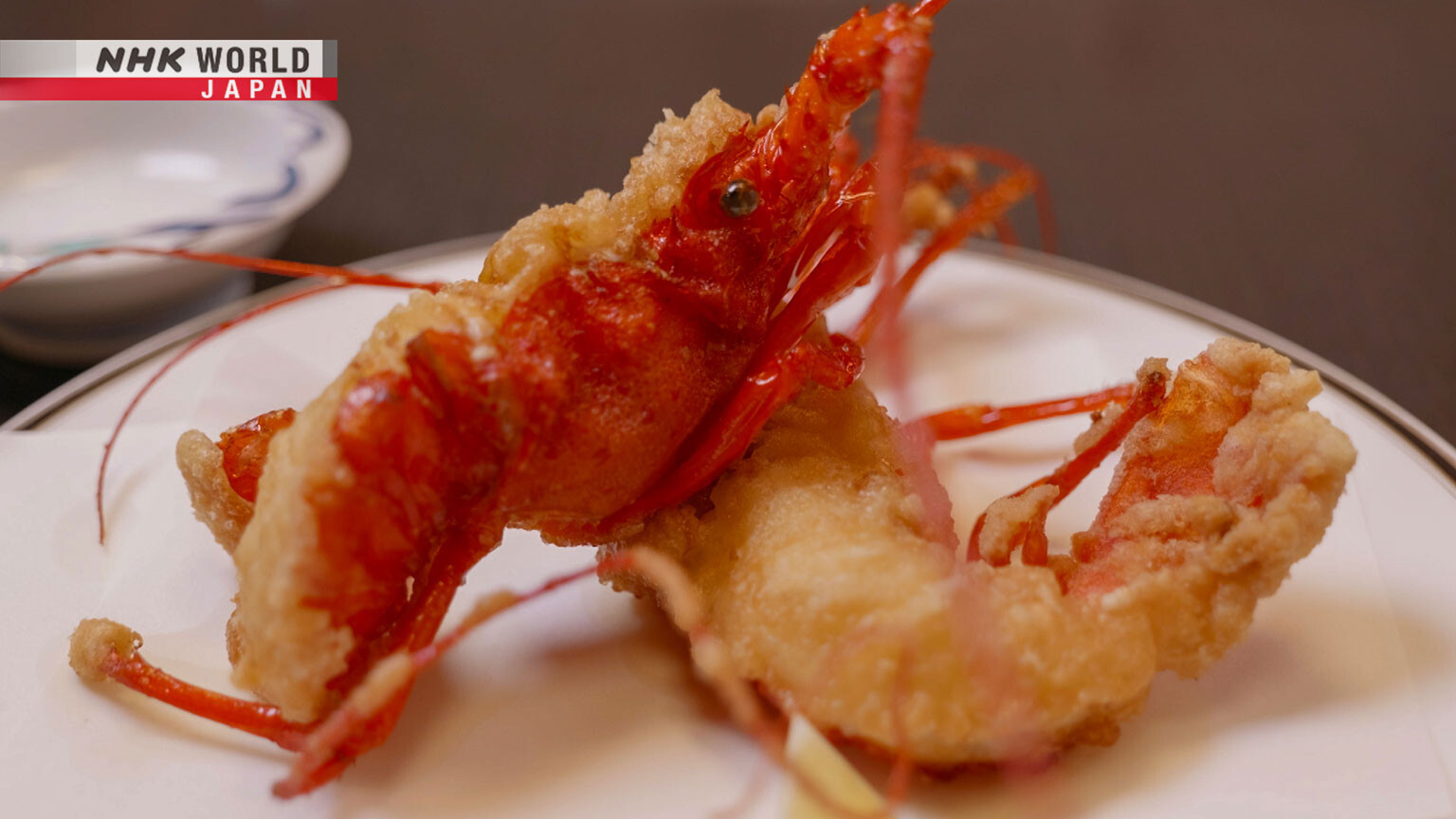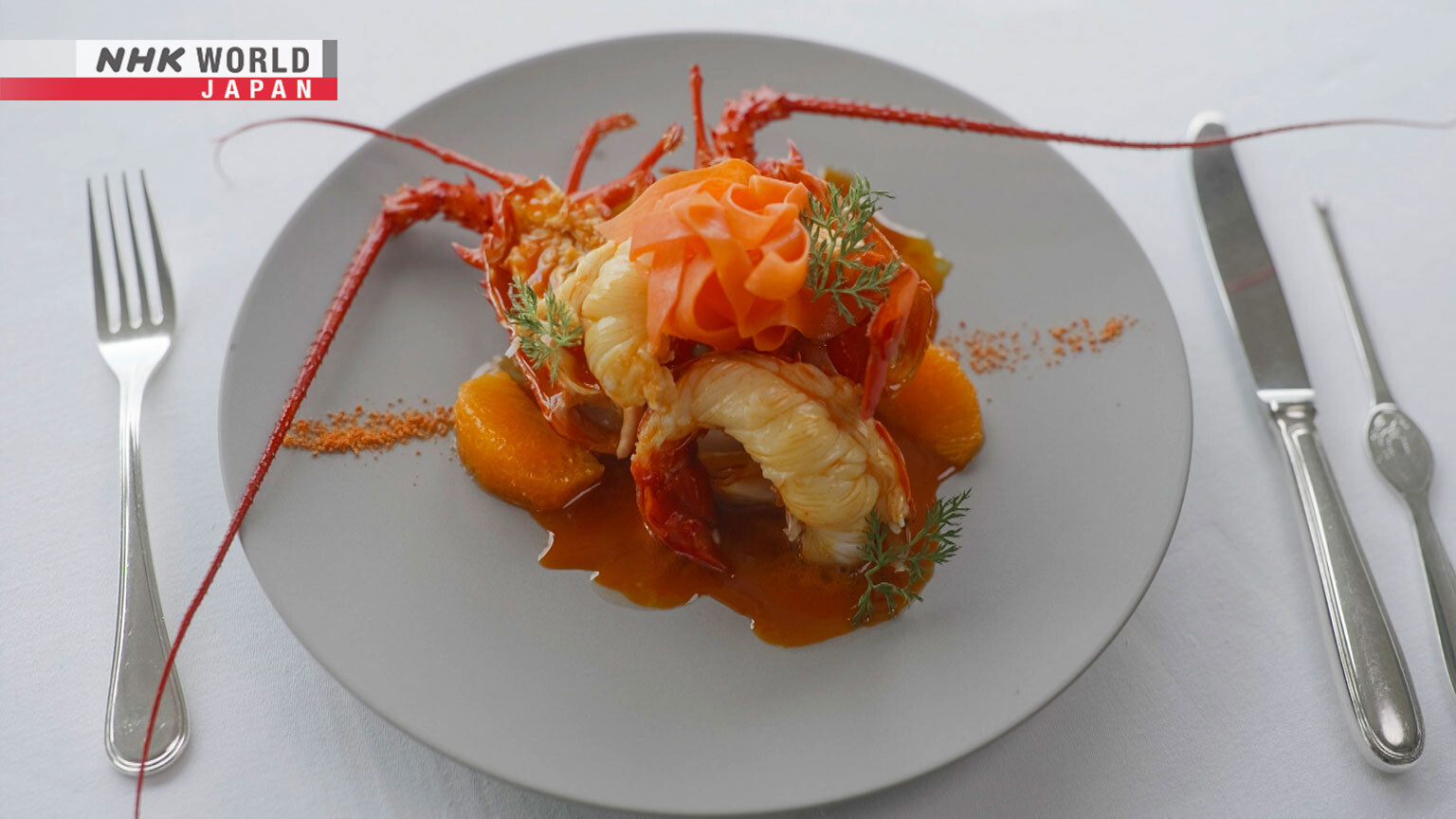ISE-EBI
Ise-ebi is the king of Japan's crustaceans. With its elegant flavor and warrior-like appearance, the high-end food is a must on festive occasions. Feast your eyes on delectable local cuisine. (Reporter: GOW)




Transcript
Tokyo: this world-class metropolis is a veritable gourmet wonderland.
Discover the stories behind the ingredients that make this city so delicious - so "oishii."
Wow!
Introducing lively Ise-ebi, or Japanese spiny lobster.
Japan is the second largest consumer of crustaceans after the United States.
But in Japan, Ise-ebi is king.
Like a bushi warrior.
Its resemblance to a samurai made it popular with warlords in the past.
Even today, it remains a key addition to festive menus.
And of course, it's delicious!
"Oishii!"
Even after a century of research, Ise-ebi remains unfarmable.
Its ecology is a true mystery of the sea.
Dive in to the magical world of the crustacean king - Ise-ebi.
Trails to Oishii Tokyo.
Hi, everyone. I'm GOW, and I'm your partner on this journey.
Ise-ebi is a popular delicacy and a high-class item in the Japanese cuisine.
I myself have only had the chance to eat a few of it.
Here in the Toyosu Market is a wholesale store that specializes in it.
Let's start from there. Follow me.
Tokyo's Toyosu Market handles products from all across Japan.
GOW arrives during the busy morning hours in search of Ise-ebi.
Such a big tuna!
So much fish.
No Ise-ebi yet.
Oh!
Here it is!
- Good morning.
- Good morning.
- Is this Ise-ebi?
- Yes.
It's so big!
Oh, it's alive!
This wholesaler, specializing in Ise-ebi for over a hundred years, is run by third-generation owner Suzuki Juichi.
Ise-ebi are kept alive in tanks while traded, because enzymes will break down the meat if they die.
Their size varies between 200 grams and over 1 kilogram.
In the spring, they can go for $70 per kilo.
- May I hold one?
- Go ahead!
- Really?
- If you can!
I'll try.
Maybe this one. Can I put my hand in there?
It's heavy!
It's so heavy.
Huge!
Ise-ebi have four antennas in total - two large and two small.
They also have 10 legs.
Unlike standard lobsters, they don't have large claws.
The shell is so strong. It looks like a samurai bushi.
Its spiny shell is one of the toughest among other crustaceans.
And it looks like armor!
This was meaningful to samurai warriors of the past.
Ise-ebi are a symbol of prayer, that warriors return home safe and victorious.
Interesting.
They're symbolic in modern times too.
The antennas, resembling long whiskers, and the lobster's bent posture symbolize health and longevity -
perfect for New Year's celebrations.
It's been cherished as a symbol of health and safety.
Fascinating.
Ise-ebi season is from winter to spring, before spawning begins.
During this time, their meat becomes sweet and plump.
Excited to transform their dishes into elegant works of art,
chefs of all cuisine styles flock here to buy some in-season.
When shipped, Ise-ebi are packed with sawdust, not sea water.
They can survive this way for about three days.
Now I want to eat some!
Where do they come from?
- ...the ocean.
- But where? Hey!
The Pacific side of Japan.
They don't live in the Sea of Japan.
They're on the Pacific side up to around Ibaraki and Fukushima.
- Are they in Ise, as the name suggests?
- Ise is great.
They get large catches.
But Ise-ebi fishers across Japan work hard to catch Ise-ebi.
- Everyone thinks theirs is best.
- That makes sense.
But Ise in Mie Prefecture is definitely home base.
Okay, I'm going to Mie to learn more about you.
The Ise-Shima region, located in Mie, is 360 kilometers west of Tokyo.
Their namesake Ise-ebi have been caught here since long ago.
The area's also known as a center for Shinto, Japan's native religion.
GOW is at Ise Jingu Shrine.
Legend states that Ise Jingu Shrine was established 2,000 years ago for the sun goddess Amaterasu.
Even today, Ise-ebi play a key role in the shrine's festivities.
The Kannamesai Festival is held every October to give thanks for the autumn harvest and pray for those to come.
Rice, rice cakes, vegetables, fruit, and seafood are offered up to the gods.
Of course, Ise-ebi as well.
How is it done exactly?
The Toba Sea-Folk Museum explains the history of sacred offerings.
So there's fruits, fish... I think that must be mochi... and rice.
Ah, and there they are. Ise-ebi.
Three Ise-ebi are placed together, steamed, and served like this.
It's the traditional way.
They're served steamed?
They turn red when steamed, and red is a lucky color.
People think of it as a power food.
Steamed Ise-ebi - food of the gods.
What does it taste like?
This restaurant specializes in steamed foods.
Ise-ebi is cooked in a cypress steamer for 20 minutes.
- I'll open it for you.
- Thank you.
It looks wonderful!
It has a lovely color.
It's beautiful. Look at this!
It's like a sun, or like a flame of fire.
Wow, it looks delicious.
- Lots of meat.
- Right.
The miso section is delicious.
Here, the word 'miso' refers to the innards.
"Itadakimasu."
No seasonings needed - enjoy the full flavor of the meat.
So good!
The Ise-ebi itself is very sweet and the texture is soft and tender.
So as you bite into it, all of these flavors mix and it creates an explosion.
It's firm and gets tastier the more you chew.
Steaming it releases excess moisture. That condenses the umami.
It's delicious raw too, but this gives it a richer flavor.
Steaming allows umami from the shell to absorb into the meat.
And don't forget to crack open the antennas - there's tasty meat inside!
Sweet!
It's plump.
Nothing to waste.
Everything is enjoyed.
"Oishii."
Next up!
This is a local specialty.
Also Ise-ebi?
Yes. The locals call this yaiko. It's molted Ise-ebi.
Ise-ebi grow larger by molting, or shedding their shell, three to four times a year.
This molted shell is still soft!
By deep-frying it (karaage style), you can enjoy both the meat and shell in one savory bite.
Wow, what a taste. It's so delicious.
It's crispy, but it also has this very sweet tender.
It's just a natural flavor that is so good.
The place that had a lot of miso, the paste, was very tender, but it had a mildness coming out of it.
I can eat the antennas and everything?
Wow, even this!
Nice.
I think a lot of Western people might like this dish.
Staff keep an eye on the tanks at night, catching and freezing lobsters as soon as they molt.
Steam or fry up some Ise-ebi to enjoy its full flavor, leaving nothing to waste.
The beautiful coast of Ise-Shima.
Nutrients flow down from national parks and mix with the warm Kuroshio Current of the Pacific Ocean,
inviting a large number of hungry fish.
GOW heads to Kuzaki Fishing Port on the region's eastern side.
Here in Kuzaki, female divers have been gathering shellfish and seaweed since long ago.
Ise-ebi fishing season is from late-November to April.
GOW's invited to join.
- Have a seat.
- Okay. Over there?
Excuse me.
Husband and wife Sakichi and Chieko are the hosts.
They work as representatives for Kuzaki fishers and divers, who all average 80 years old.
- She's an active diver.
- Really?
I'm not as good as I used to be.
But you still do it. Amazing!
All boats head off at 2PM.
The starting time is set in place to prevent overfishing.
Cool!
Wow, look!
All at once, all of these boats are going to get the Ise-ebi.
It's like they're out for battle.
Good luck, everyone!
Fishing spots are also designated to protect resources.
The race is on to get there first.
Sakichi revs the engine like a champ to reach the location.
I see rocky areas.
They stop about 1 kilometer out from the port.
He knows from experience where in the reef areas Ise-ebi can be found.
Throw it in.
She started?
You'll catch them with a net?
She releases a 130-meter-long gill net.
Ise-ebi are found in depths of around 2 to 30 meters.
The nocturnal creatures come out from rocky holes to feed at night.
Fishers set up large nets to catch them in the act.
The gill nets are dropped over the rocky surface during the day.
When the Ise-ebi come out to feed at night, their legs get tangled.
Sakichi knows the ocean floor like the back of his hand.
He tells Chieko when and where to drop the nets.
Drop it.
He carefully adjusts his speed along the way.
For example, he slows down in deeper waters to make sure the nets make it down to the rocks.
Now.
Each boat only has five nets.
Once they're set, fishers return to the shore and let nature take over.
When we bring in the net tomorrow, it'll be filled with Ise-ebi!
Well, there are ups and downs. Sometimes we get nothing. We'll see!
- Here's to a great tomorrow!
- Yes!
5AM the next morning.
They head out to where they set the nets to see how they did.
Here, here!
This way!
If the water temperature falls even by one degree, the lobsters won't come out at night.
Sometimes, the race to put out nets is all in vain.
It's a bit of a gamble.
It's small. Can you see it?
See the small ones?
There's one! This is noisy.
- Small ones.
- Lots of those.
Where are the big ones?
They're cute.
- Three of them.
- Here we go.
- A big one!
- Yes!
Due to unstable weather, fishers can only go out around 10 days out of the month.
On this day in mid-March, they caught a bit less than usual - 8 kilograms.
Back at port, Ise-ebi are removed from the nets.
Using a special hook, fishers are careful not to damage anything.
Ise-ebi fetch a lower price if they're missing a leg or antenna.
To keep them intact, sometimes the nets have to be cut instead.
We have to cut the net, but that happens.
Global warming and other factors have caused fish numbers around Mie to decline in recent years.
In response, Kuzaki Fishing Port has set its own rules,
including extended no-fishing periods to promote stable catches.
Time to try freshly-landed Ise-ebi.
Chieko will take the lead.
Looks juicy.
We soak the meat in salty ice water.
- Just a bit of soy sauce.
- Yeah, so you can taste the meat too.
"Itadakimasu."
How is it?
I have no words.
Tasty, plump and sweet.
We don't usually get to eat what we catch.
Great texture.
Sweet.
It's great.
Yes, and you caught it yourself!
It's an honor.
You came at the best time.
I'm so happy.
This Ise-ebi has given you 20 more years of life.
I can live long? Yes!
I hope to be as healthy and energetic as you two.
You have to be healthy to catch Ise-ebi.
We have to stay strong. We'll catch Ise-ebi for as long as we can.
- And those who eat it will be strong too.
- That's the way.
Ise-ebi, a symbol of longevity.
Perhaps eating ones caught by lively fishers will help you live even longer!
In Japan, Ise-ebi fishing is banned during the summer spawning season.
After hatching, Ise-ebi larvae drift around in the Pacific Ocean for a year
before settling on rocky floors, where they eventually grow and develop shells.
The Mie Prefecture Fisheries Research Institute studies the cultivation and release of juvenile Ise-ebi.
But with details of their ecology still unclear, farming technology remains undeveloped.
Mysterious Ise-ebi will be expensive luxuries for a while longer...
GOW's final stop is a lovely French restaurant in a hotel overlooking the ocean.
She'll try innovative food in the heart of Ise-ebi land.
A legendary chef known for reinventing the wheel of Japanese French cuisine used to work here.
Takahashi Tadayuki.
He made French cuisine using locally-sourced Japanese ingredients, rather than imported products.
In doing this, he brought new life to Japan's gastronomy culture.
His Ise-ebi cream soup was highly praised by master French chef Joel Robuchon.
Seventh head chef Higuchi Hiroe keeps this recipe alive.
Thanks for waiting.
Thank you.
Wow. No sign of Ise-ebi anywhere.
The soup itself is orange.
- "Oishii."
- Thank you.
The taste is very thick and savory, but it also is very refreshing.
The Ise-ebi taste of the sweetness,
the saltiness and also the umami is all compactly put into - compressed into this soup.
It's very delightful.
It is very classy as well.
Chef Higuchi upholds her predecessor's philosophy of maintaining freshness
regardless of cooking method - natural flavor in any form.
The hotel's cream soup is a perfect example.
Pieces of Ise-ebi with shells intact are sauteed in butter with carrots and onions,
cooked with rice, and processed in a blender.
All flavors of the spiny lobster - from the meat, the shell and the miso - are condensed into a creamy soup.
Natural flavor in any form!
Chef Higuchi received a medal from a French minister in recognition of her talents.
With her predecessor's philosophy in mind, she pursues her own unique style.
Today, she'll cook with a local citrus fruit called Setoka.
Known as the fatty tuna of citrus, it's distinctively thick and juicy.
A rich sauce is made by simmering setoka with carrots.
Beautiful!
I can't even imagine how this dish is gonna taste.
The part with the paste is so good.
It brings out a little bitterness to the sweetness,
and it gives you a new layer of the taste.
It's so good. It's obviously a work of art.
Fishers catch Ise-ebi, a local specialty, with our future in their hearts.
Ise-ebi have sweetness and umami, but an overall delicate flavor.
Cooked, they have a beautiful red color.
Customers smile when they see such beauty. Ise-ebi are truly a gift from the sea.
On this journey, I have learned about the deep connection of the Japanese culture
and the Ise-ebi which have started thousands of years ago.
There are still so many unsolved mysteries upon this wonderful creature,
but what I can tell you is the warrior-like red shell has a significant presence.
And the insides that are sweet and firm and has a rich taste are unforgettable.
In Tokyo, and Mie, every ingredient has its own story.